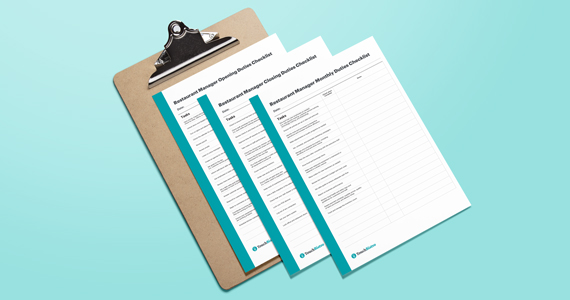You’ve got Nathan, who’s always late; Jodi, who keeps seating the wrong sections; Alex, who never buses his tables; Alice and Will, in a power struggle for bar manager; and all the while, you’re balancing your FOH vision, while trying to be on the same page with the head chef.
Being a restaurant manager is a constant balancing act. While you bleed customer service, the fabric of your being is stitched together by the need to manage people. But just because you’re a people person doesn’t mean you’re a people pleaser. There are many restaurant management books that teach ways to manage and run a tight ship, a smooth line, all while ensuring exceptional customer service.
In a landmark study on leadership, psychologist Daniel Goleman outlined six management styles drawn from over 3000 mid-level managers. Here, we’ll apply them to the restaurant industry and determine where each style works… and where they fall short.

Use these daily and monthly checklists to keep restaurant managers on track and operations running smoothly.
The Coercive Leader
“Because I said so.”
This is the “mama knows best” approach to leadership.
The pros to this management style? Coercive leaders can make decisions on the fly, exude confidence, and always appear to have control. They also demand that everyone follows their lead without question. Often the quick and direct decisions made by coercive leaders are appreciated by guests, who feel that, indeed, they’ve spoken to the person in charge. When there’s a crisis, this directive style of management shines.
While this style is effective if say, your kitchen is on fire, the cons are that often, these managers can come off as patronizing and unwilling to compromise or listen to the opinions of their staff and colleagues. This can lead to staff feeling like they’re undervalued and that their manager doesn’t have confidence in their decision making abilities.
The Democratic Leader
“A show of hands, please.”
In contrast to the previous approach, a democratic leader favors majority rule. They bring their staff into decisions, seeking opinions on new menu items, new specials, and policies. If management is in need of staff buy-in, a democratic leader shines. Everyone feels valued when a democratic leader works their magic by fostering a sense of community.
The cons? You know the phrase, “Too many cooks in the kitchen?” Well, it might be more literal and less figurative with the democratic leader. Sometimes, they’re seen as lacking confidence and unsure of their decision making power. In times of crisis, say an extraordinarily busy night or an irate customer, these leaders MIGHT come off as wishy washy.
The Affiliative Leader
“We’re not co-workers; we’re a family.”
This kind of manager values harmony amongst their staff and puts the development of their people first. Why? Because “we’re not just co-workers; we’re a family.” They give their staff a sense of inclusion. Some of these leaders may insist the entire team eats together before service begins, while others may insist everyone stays for a night-cap at the end of the evening shift. The family-vibe rubs off on the guests who also feel included in the bubble of love.
The cons? Well, imagine working with your mother. All is smooth sailing, love and support, until it isn’t. When a staff member underperforms or starts taking advantage of the nurturing support, the line between business and personal becomes blurred. Roles get crossed and rifts in the family unit are felt more tangibly across the entire restaurant, instead of being dealt with briskly and professionally.

Use these daily and monthly checklists to keep restaurant managers on track and operations running smoothly.
The Authoritative Leader
“Let’s go.”
When it comes to big, team-oriented goals, the authoritative leader gets the job done. They motivate. They give clear direction. They define roles and give staff enough autonomy to make everyone feel valued. Do you have a goal to sell a featured beer or meet a sales goal? The authoritative leader will convey the importance of that goal and motivate workers through feedback.
Where the authoritative leader falls short is when they’re dealing with equals, when a staff member is underdeveloped, or when they do something to put their own credibility in question. They must be sure to always walk the walk, talk the talk, and listen when multiple parties have something to say.
The Coaching Leader
“You can do it!”
The future is always top of mind for the coaching leader. For the high turnover restaurant industry, these leaders are hard to leave. A coaching leader’s guidance is especially helpful when working with staff as a restaurant mentor. This is because a coaching leader gives staff lower on the totem pole the tools and opportunities needed for growth.
Perhaps they’ll let the salad cook try sauté on a slow evening. Or, maybe they’ll proactively prepare a host for serving duties by allowing them to shadow or spend more time with tables.
Where this leader struggles is when a staff member just isn’t working out. They’re so keen to see progression, that there’s the potential for making HR errors in judgment.
The Pacesetting Leader
“Do as I say and as I do.”
Both an example and a leader, the pacesetting leader sets the standard by which they believe the staff should act. They have great tableside manner, they’re not above running food or getting behind the bar on a busy night. Heck, they’ll hop on line or on the host stand if they need to.
While they’re not afraid to get their hands dirty, at times they might get their hands too dirty. They might not always ask for help when they need it, and since they set the standard of excellence so high, employees might feel pressured by the demands the pacesetter places upon them. Kind of like a parent who has a “my way or the highway approach,” if they’re not careful, the pacesetter can enter this territory.
At the end of the day, no management style works 100% of the time – there is no one size fits all. You shouldn’t ascribe to any one style, but be adaptable based on the circumstances and the specific people you’re dealing with. The smoother and quicker you can determine how you should show up for the people in your work environment, the more effective of a leader you will be.

Avoid these bad habits that can wreak havoc on your business success.
Download your free employee handbook template
Sign up for our free weekly TouchBistro Newsletter







